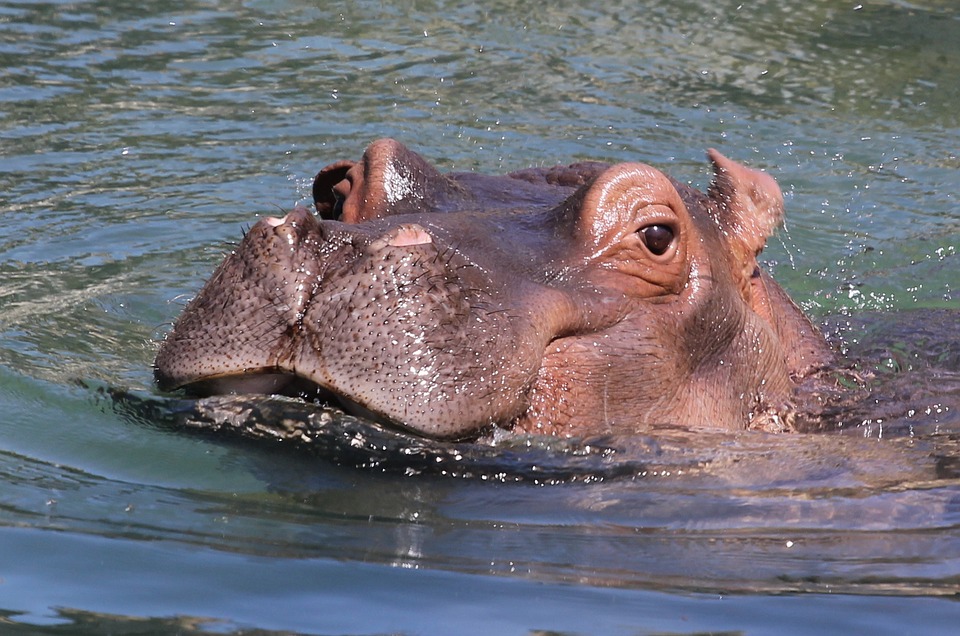Zebras zählen in Südafrika – Safari Urlaub im Artenschutz
14. Juli 2016
Umsiedlung von 5 Happy Hippos in den nahrungsreichen Süden des Landes geglückt – ein besonderes Safari Erlebnis.
5. August 2016
Africa Geographic erkundet Artenschutz Safari in Südafrika
Once upon a time in a reserve not far, far away from Cape Town, the team at Africa Geographic spent a magical weekend frolicking in the fynbos. Having recently published the 100th issue of this online magazine and reached one million likes on Facebook, the gang had two more goals to check off their list – to celebrate and to check out the new eco-camp that has recently opened on Gondwana Game Reserve.

Gondwana eco-camp from above ©Lantern Works

Enjoy some downtime on the deck of your tent in Gondwana’s eco-camp ©Lantern Works
British citizens who live to the ripe old age of 100 can expect a letter from the Queen, but the Africa Geographic team had an even better way to applaud their longevity – a weekend of bush braais, camera trapping, alien tree extermination, swamp monitoring, safari drives and game counts!
Amarula and fleece pyjamas to confront the winter
So it was that 12 caffeine-fuelled members of Africa’s publishing and safari industry journeyed to this Big Five game reserve along the Garden Route, armed with fleece pyjamas and a bottle of Amarula to take the edge off the cold winter nights. Accompanied by the talented production team at Lantern Works, everyone was ready and raring to come out from behind their keyboards and fight on the frontline for conservation!

Three of the Africa Geographic girls – our Sales Lioness, our Community Manager and our General Manager (from left to right) ©Kelly Winkler

Making a little difference in a big reserve ©Lantern Works

The very versatile videographer, Rowan Jackson from Lantern Works, is caught on camera ©Kelly Winkler
A look behind the scenes
The beauty of Gondwana’s eco-camp stretches far beyond its rolling hills, its six endemic bird species and its unique fynbos vegetation. It rather lies in the opportunity that it offers visitors to really get their hands dirty and contribute to the long-term conservation efforts in a precious part of the continent. It allows the lovers of Africa’s wild places to park their Land Rovers and be whisked away in an open safari vehicle to a remote corner of the 11,000 hectare reserve, where six luxury tents are permanently pitched along with ideas as to how to save the environment and protect wildlife.
Running off renewable energy and french press coffee, a stay at this camp is the perfect way to ease yourself into the wilderness. It brings you back to basics, while providing certain creature comforts that allow for a good night’s sleep and an overall relaxing break. It offers the best of both worlds – a view of the Milky Way and the use of Le Creuset – with some special South African touches thrown in to warm the heart and fill the belly.

A traditional South African potbrood in the making ©Lantern Works

Everyone has that one friend… ©Simon Espley

The interior of one of the luxury tents at the eco-camp ©Lantern Works
Click here for more INFO and BOOKINGS of the Conservation Safari program on the Garden Route
Mehr INFORMATIONEN und BUCHUNG der Artenschutz-Safari Programms in Süd Afrika
Keeping track of the wildlife
After counting sheep then dreaming of the delicious potjie we had devoured for dinner, we started our first day in the bush by counting game. Game monitoring is vital in a private reserve in order to maintain a balanced ecosystem and keep track of the wildlife populations. The research and findings from such activities are then fed back to Gondwana’s conservation department to help make decisions that will hopefully enhance the reserve’s management plan.

A Burchell’s zebra stands its ground ©Kelly Winkler

A crucial compass to help plot the location of various game ©Lantern Works
Fynbos, the primary vegetation on the reserve, is endemic to the Cape and is largely responsible for attracting unique birdlife and mammals to the region. More than 10 species of antelope can be found in the reserve, including kudu, eland, gemsbok, bontebok and grey rhebok. As a result of this biodiversity, the monitoring of fauna and flora understandably plays a crucial role at Gondwana.
The movement patterns and general distribution of the animals, as well as the impact of key species on vegetation, are the main factors that need to be monitored on a regular basis. And we were only too happy to go on a game drive to tally up the wildlife, record their GPS coordinates and try to recall past orienteering skills when faced with the threat of a compass.
Installing camera traps also proved to be an interesting exercise, and our attempts were fruitful as the footage eventually revealed some sneaky visits from a large-spotted genet (Genetta tigrina), a marsh mongoose (Atilax paludinosus) and a caracal (Caracal caracal)!

Our guide, Stevie, teaches us how to use a camera trap ©Lantern Works

A caracal is caught on camera! ©Gondwana Game Reserve
Going with the flow
After the morning’s excitement and a hearty lunch back at camp, we then scooted off to conduct a miniSASS. In the shake of a Cape sugarbird’s tail feather, we found ourselves at the reserve’s swamp, where we were handed fishing nets along with a bit of advice to try not to fall in.
MiniSASS is an invaluable tool that helps conservationists to monitor the health of a water source. Steadied by our nets as we maneuvered around hippo tracks on the banks, we had the chance to relive our childhoods by collecting samples of macro-invertebrates from the water. These findings were then used to measure the general health of the water, depending on the groups that were found.
The biodiversity in the water is indicative of its quality, but we unfortunately didn’t have much luck that sunny afternoon and only managed to surface a couple of water boatmen, a lone diving beetle, various dragonfly and damselfly larva, and a lot of mud. However, it was interesting to explore this side of the reserve and gain a better understanding of how healthy water systems influence their surroundings. After all, Jacques Cousteau would have been quick to remind us how “we forget that the water cycle and the life cycle are one.”

Playing the part on the banks of the swamp ©Lantern Works

Searching in earnest for what may lurk beneath the water’s surface ©Lantern Works

A diving beetle lends itself to inspection ©Lantern Works
Throttle the wattle
After another deep sleep thanks to the fresh air and the sounds of the wild, the first thing on the next day’s agenda was to throttle the wattle!
The encroachment of alien vegetation is one of the reserve’s greatest environmental threats. Subsequently, Gondwana is on a mission to reduce the number of Invasive Alien Species (IAS) that are rearing their ugly heads. The dominant alien species are primarily of Australian origin and include black wattle (Acacia mearnsii), red eye wattle (Acacia cyclops) and silky hakea (Hakea sericea), and they are guilty of using much more water than the indigenous fynbos vegetation, while also taking over areas so that no indigenous biodiversity can thrive.

Clockwise from top left: Ringbarking a tree; slicing the bark with a machete; peeling back the bark; spraying with herbicide to prevent re-growth ©Lantern Works
Gondwana supports some of the most critically endangered vegetation types in the world, which would be under intensive threat if the land were used in an alternative way. However, vegetation assessments conducted in 2011 revealed the reserve to have 501.55 hectares of alien dominated vegetation dispersed in pockets – predominantly in valleys, wetland and riparian zones. Gondwana has thus embarked on one of the largest full-scale IAS removal projects in the Southern Cape, with the main focus being to clear dense stands of black wattle (Acacia mearnsii) from the fynbos and riparian zones so that it cannot compromise the reserve’s natural biodiversity by utilising valuable water.
Large tracts of the reserve have already been cleared thanks to a combination of manual, mechanical and chemical removal methods. Many of these sites have started to recover thanks to wise veld management, and they will continue to be rehabilitated with indigenous vegetation and maintained to ensure that no invasive species return.
Us lucky participants had the opportunity to learn more about this lesser considered issue and to participate in the eradication of the targeted species at hand. This project is of a long-term nature but, after a morning spent pulling and thrashing, we’re sure the results will be well worth it and we are happy that we could play our small part.

Getting to the root of the problem! ©Lantern Works

Another spectacular sunset in the Southern Cape ©Lantern Works
Game for a drive
Gondwana Game Reserve is the only free ranging Big Five private wildlife reserve in the Southern Cape, and elephants and lions have been known to casually stroll by the lodge on occasion. The first giraffes took their first steps on Gondwana soil back in 2012, and new key species, such as hippo and cheetah, can also now call the reserve home.
What’s more is that Gondwana is responsible for the recent reintroduction of the first black rhinos to the province, which means that the reserve is now the only place in the region where you have the chance to watch a black or white rhino roam free at sunset against the backdrop of the Outeniqua and Langeberg mountain ranges. Both of these species are protected under 24-hour surveillance and are commonly seen grazing on the open plains. And we couldn’t have planned it better on our final game drive, as we spent time with a pregnant white rhino and her mate while they lovingly jostled a few metres from our vehicle. Seeing two white rhinos was the big finale to celebrate Africa Geographic’s big milestone and, as we drove back to camp to enjoy our last braai and crack open a bottle of pinotage, we couldn’t have been more thankful to live in this corner of the world.

An elephantastic sighting ©Lantern Works

The delight of watching a white rhino at sunset ©Lantern Works
Watch the video from our wild weekend here:
Important bits and bobs
Gondwana Game Reserve’s main lodge is arguably known for its unique accommodation that offers a modern twist to traditional Khoi-San dwellings. Each open plan suite provides the ultimate in luxury and privacy, and the large infinity pool, elegant dining room and chic bar all serve to create a romantic idyll and space for relaxation.

The luxury open plan suites at Gondwana’s main lodge ©Lantern Works

Dive into decadence at a private lodge on the estate ©Lantern Works
However, the eco-camp works a bit differently. Located in a remote corner of the reserve, it sleeps 10 guests in five comfortable twin or double tents that each have an ensuite bathroom, so it’s the perfect place for a group getaway rather than a couple’s escape.
All meals are served communally by the fire or in the main tent, which includes an open plan kitchen, lounge and dining area. And fortunately for us, the team is happy to stock the camp fridge to your heart’s desire, so don’t be scared to make any dietary requests. In our group, one person was on the Banting diet, one allergic to chilli, one vegetarian and one grossed out by lamb, but everyone was catered for meticulously. There is also a well-stocked bar fridge but, if you have specific requirements, you may want to bring your own booze to keep you entertained around the fire in the evenings or to enhance the delicate notes of your burger at lunch.
If you’re heading down to this corner of the continent between June and August, be sure to bring some warm clothing because winter in the Cape can be colder than a brass toilet seat on the shady side of an iceberg. However, in the summer you may fancy lounging by the camp’s pool in your spare time, so don’t forget your costume and sunscreen. And no matter what the time of year, closed sneakers or hiking boots are a must, as you’ll be out all day getting grubby!
But most importantly, don’t forget your camera to capture the magnificent memories that you’re bound to make over the course of either the three-night or five-night programme at the eco-camp.
Adventure awaits! What are you waiting for?

Click here for more INFO and BOOKINGS of the Conservation Safari program on the Garden Route
Mehr INFORMATIONEN und BUCHUNG der Artenschutz-Safari Programms in Süd Afrika
Directly to the article on Africa Geographic website: – See more at: http://magazine.africageographic.com/weekly/issue-109/a-fynbos-safari/#sthash.QeOOXm8S.dpuf
About the author
 MEI CAPES is half-Chinese, born in England, and South African at heart. She received a BA Joint Honours in French and German from the University of Warwick before spending a decade bumbling around Asia, Central America, Australia and Europe, then settling in Cape Town.
MEI CAPES is half-Chinese, born in England, and South African at heart. She received a BA Joint Honours in French and German from the University of Warwick before spending a decade bumbling around Asia, Central America, Australia and Europe, then settling in Cape Town.
Tired of pretending to be a grown-up, she takes every opportunity she can to explore her new home continent, accompanied by anyone who can understand her North London accent.





